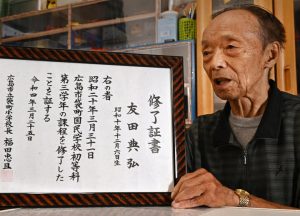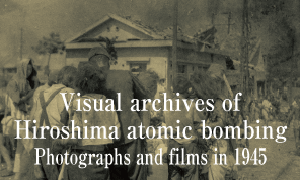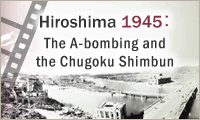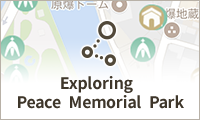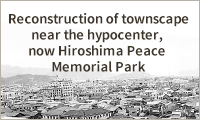Memories engraved in A-bombed buildings, Part 2: Fukuromachi Elementary School
Jul. 22, 2024
Considering “messages” left on wall
by Minami Yamashita, Staff Writer
“Fusako Kawamoto, inside Tayama Honten.” On July 4, 2024, Tomoe Tayama, 82, visited the Fukuromachi Elementary School Peace Museum, located in Hiroshima City’s Naka Ward, and stared intently at those words, which had been written in chalk on a wall of what was then Fukuromachi National School amidst the chaos after the atomic bombing. The shop name is believed to refer to “Harima Tayama Honten,” a women’s clothing fabric shop that Mr. Tayama manages on the nearby Hondori shopping street. On this day, he encountered the “message” for the first time, 79 years after the atomic bombing.
Tayama Honten, which opened for business in the early Meiji era (1868–1912) of Japanese history, had been closed during the war due to restrictions on supplies and was being used as a dormitory for the West Police Station (present-day Hiroshima Chuo Police Station). Mr. Tayama was three years old at the time of the atomic bombing and had been evacuated to Hatsukaichi City. He heard from his father that “my aunt and several police officers had died there.” The shop was located around 430 meters from the hypocenter, and the entire building, its supplies, and the surrounding city were all destroyed in the fires that arose after the bombing.
Reluctant to visit alma mater
The wall of the Fukuromachi National School’s ferroconcrete building, which barely survived the fires, were turned into a message board by which citizens could inquire about the whereabouts of family and friends. From the results of a survey conducted by the Hiroshima City government to decipher the messages in 2000, Mr. Tayama first learned of the fact that the name of his shop had been written on the wall. However, he said he was “afraid to look at the wall because it would be like seeing the devastation from that time.” Although his alma mater was only around a three-minute walk from his home, he said he just could not bring himself to visit the message board.
Norihiro Tomoda, 88, an A-bomb survivor who lives in Kadoma City, Osaka Prefecture, knows the devastation from the atomic bombing firsthand. Mr. Tomoda, one of only three students at the school who survived in what is known as the “miracle in the basement,” is still alive and well. In the fourth grade at the time, he experienced the atomic bombing as he was changing his shoes in the area around the school’s shoe lockers. He said, “As I was late for morning assembly, an older student grabbed my arm at the school gate and told me to come quickly. I told him to ‘shut up,’ shook him off my arm, and went downstairs. If I had done as I was told, I would have died.”
Mr. Tomoda’s younger brother, Yukio, who was in the second grade, had already gone out onto the school’s grounds, resulting in his body being charred black in the bombing like other students. Mr. Tomoda was able to identify Yukio by the lettering that spelled out “Tomoda” on his shoes. Yukio was Mr. Tomoda’s only brother, and they would often play together, catching shrimp in the Motoyasu River and flying handmade gliders from the rooftop of the school building. He had no choice but to say, “I’m sorry” to Yukio, before fleeing to Hijiyama Hill (in Hiroshima’s present-day Minami Ward).
“Remembering dead bodies”
Mr. Tomoda’s father had died of illness, and his mother went missing after the atomic bombing. Becoming an orphan when he was nine, Mr. Tomoda traveled to the Korean peninsula with a Korean man who had been boarding at his home. At the age of 24, after suffering much hardship, he returned to Japan. In the living room of his house is displayed a special graduation certificate he received from Fukuromachi Elementary School in 2022. He said, “Fukuromachi Elementary School is a special place for me. But when I see the certificate, I am reminded of all the dead bodies on the school’s grounds.”
When Mr. Tayama visited the Fukuromachi Elementary School Peace Museum the first time, he recalled the devastation of that day, August 6, 1945, and for a time became stuck in place in front of the wall. The name of the shop “Tayama Honten” was barely legible to the naked eye, but he quickly found it. “Because it is my shop,” he explained.
Directly to the left of Ms. Kawamoto’s name is a sentence that reads, “To those who know the whereabouts of the person indicated at right, please notify the address at left,” indicating a name and an address in Kure City. “What kind of work did Ms. Kawamoto do and what kind of person was she?” Filled with such thoughts about the message board from 79 years ago, this Chugoku Shimbun staff writer will visit Peace Memorial Park on August 6 again this year, recite her name, and put my hands together in prayer for the repose of her soul in front of the Cenotaph for the A-bomb Victims and the Atomic Bomb Memorial Mound.
Keywords
Fukuromachi Elementary School
The school’s ferroconcrete west building was completed in 1937. The modern school building, composed of one basement floor and three floors aboveground, was equipped with flush toilets and garbage chutes. At the time the atomic bomb was dropped on Hiroshima, students in the third grade and older had been evacuated to the countryside. The school was located 460 meters from the hypocenter, with around 160 students, teachers, and other staff thought to have been at the school at the time, most of whom died in the atomic bombing. Immediately after the bombing, the school was turned into an aid and relief center, and the “messages” written in chalk on the soot-covered wall seeking information about the whereabouts of people were discovered in 1999. In 2002, part of the school building was opened as a peace museum. The museum is scheduled to be renovated and reopened in November 2026 as an exhibition facility affiliated with the Hiroshima Peace Memorial Museum.
(Originally published on July 22, 2024)



